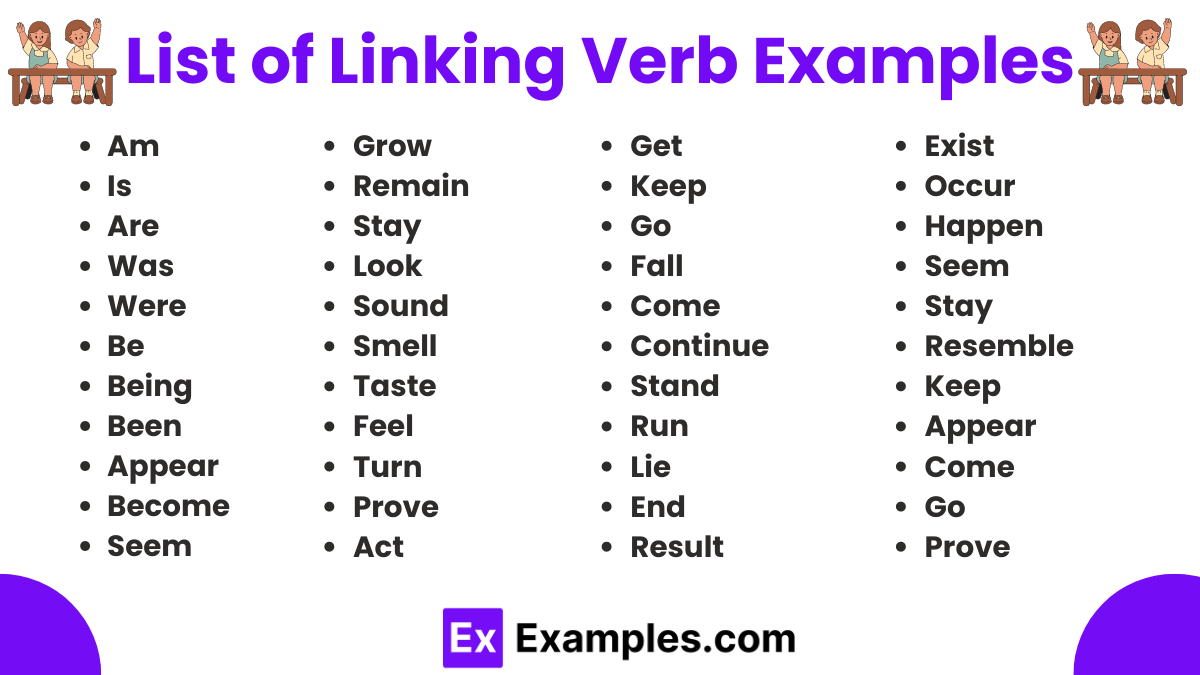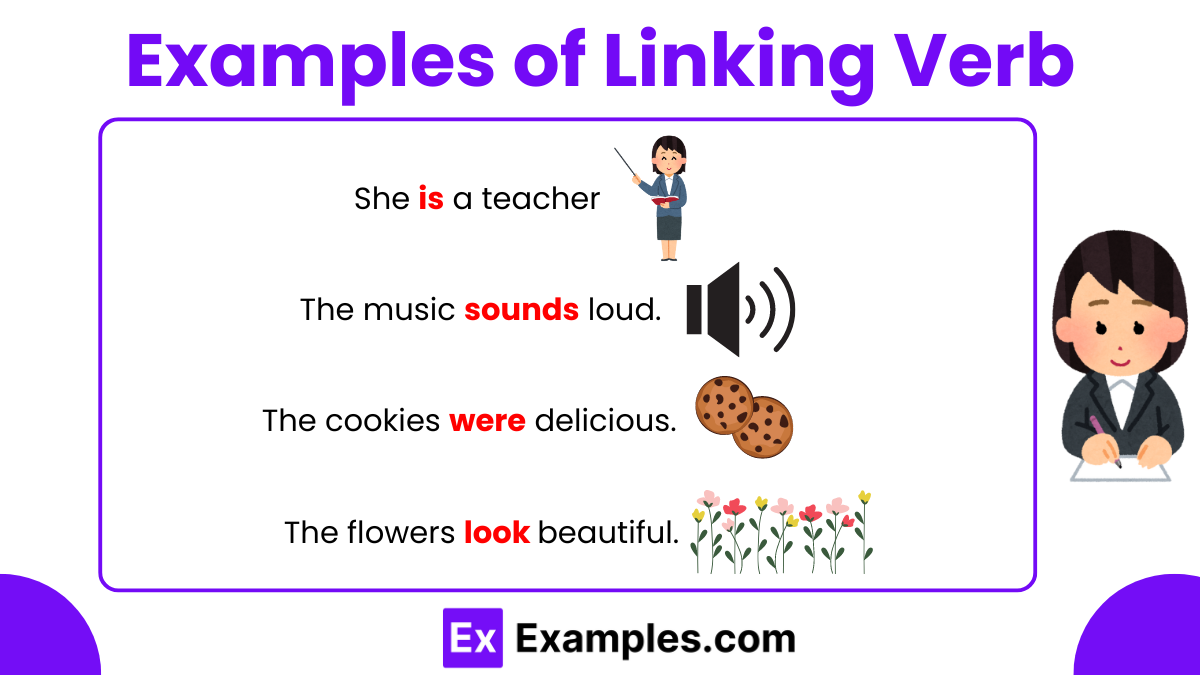70+ Linking Verb Examples
A linking verb connects the subject of a sentence to additional information about that subject, serving as a bridge to describe or identify it. In English grammar, linking verbs are essential because they link the subject with a noun, pronoun, or adjective that provides more detail. Common linking verbs include “am,” “is,” “are,” “was,” and “were.” These verbs do not show action but rather a state of being or condition, helping to complete the meaning of sentences by tying the subject to descriptive words or phrases. Understanding linking verbs is crucial for mastering the fundamentals of English grammar and improving sentence structure.
What is a Linking Verb?
Types of Linking Verb
1. Forms of “To Be”:
These include “am,” “is,” “are,” “was,” “were,” “be,” “being,” and “been.” They link the subject to a state of being or condition.
2. Sensory Verbs:
These verbs describe senses and include “look,” “sound,” “smell,” “taste,” and “feel.” They link the subject to sensory descriptions.
3. Verbs of Becoming:
These verbs indicate a change of state and include “become,” “seem,” “grow,” “turn,” “appear,” and “remain.” They link the subject to a new state or condition.
List of Linking Verb Examples

| Am | Appear | Get | Continue | Result |
| Is | Become | Keep | Stand | Exist |
| Are | Seem | Go | Run | Occur |
| Was | Grow | Fall | Lie | Happen |
| Were | Remain | Come | End | Seem |
| Be | Stay | Continue | Result | Stay |
| Being | Look | Stand | Exist | Resemble |
| Been | Sound | Run | Occur | Keep |
| Appear | Smell | Lie | Happen | Appear |
| Become | Taste | End | Seem | Come |
Examples of Linking Verb in Sentences

- She is a teacher.
- They are excited about the trip.
- He was tired after the game.
- The cookies were delicious.
- I am happy today.
- The sky is blue.
- It has been a great day.
- The cake smells wonderful.
- The flowers look beautiful.
- The soup tastes salty.
- The room feels cold.
- She seems upset.
- He became a doctor.
- The situation appears difficult.
- The music sounds loud.
- They remained calm during the storm.
- The milk turned sour.
- She stayed quiet.
- The decision proved wise.
- The project continued smoothly.
Rules of Linking Verb
- 1. Link Subject to Complement: A linking verb connects the subject to additional information.
- 2. No Action Indicated: Linking verbs do not show action. Instead, they describe a state or condition.
- 3. Use Forms of “To Be”: Forms of “to be” such as “am,” “is,” “are,” “was,” and “were” serve as linking verbs.
- 4. Sensory Descriptions: Sensory verbs like “look,” “smell,” “feel,” “taste,” and “sound” act as linking verbs when describing the subject’s state.
- 5. Indicate Change of State: Verbs like “become,” “grow,” and “turn” show a change in state. For example, “He became a musician.”
- 6. Followed by Adjectives or Nouns: Linking verbs are often followed by adjectives or nouns that provide more information about the subject.
- 7. No Direct Objects: Linking verbs do not take direct objects. They connect the subject to a subject complement.
- 8. Can Be Replaced by “=”: If you can replace the verb with “=” and the sentence still makes sense, it is likely a linking verb.
- 9. Can Exist in Various Tenses: Linking verbs can appear in different tenses to match the sentence’s context.
- 10. May Combine with Helping Verbs: Linking verbs can pair with helping verbs to form different tenses.
Functions of Linking Verb
- Describe State of Being: Linking verbs describe the subject’s current state.
- Connect Subject to Adjective: Linking verbs link the subject to an adjective that describes it.
- Connect Subject to Noun: Linking verbs link the subject to a noun that renames or identifies it.
- Indicate Sensory Experience: Linking verbs describe sensory experiences of the subject.
- Show Change of State: Linking verbs indicate a change in the subject’s state or condition.
- Provide Subject Complement: Linking verbs provide additional information about the subject through a complement.
- Link to Condition: Linking verbs link the subject to its condition.
- Identify Role or Identity: Linking verbs identify the subject’s role or identity.
- Describe Appearance: Linking verbs describe how the subject appears.
- Convey Existence: Linking verbs convey the existence or presence of the subject.
How to Use Linking Verb
A linking verb connects the subject to a description or identity without showing action.
Link Subject to Adjective
Use linking verbs to connect the subject to an adjective.
Link Subject to Noun
Use linking verbs to connect the subject to a noun that identifies it.
Describe Sensory Experiences
Use sensory verbs as linking verbs to describe how something looks, sounds, smells, tastes, or feels.
Indicate Change of State
Use verbs like “become” and “grow” to show changes in state or condition.
Follow with Adjectives or Nouns
After linking verbs, use adjectives or nouns to provide more information about the subject.
Use in Different Tenses
Apply linking verbs in various tenses to match the context.
Pair with Helping Verbs
Combine linking verbs with helping verbs for different tenses.
Avoid Direct Objects
Do not use direct objects with linking verbs.
Use for Identifying Roles
Employ linking verbs to identify the subject’s role or identity
Ensure Correct Usage
Replace the verb with “=” to test if it’s a linking verb.
How to Identify a Linking Verb?
Identify a linking verb by checking if it connects the subject to a description or identity, not showing action, often replaceable with “=”.
Is May Become a Linking Verb?
Yes, “may become” can act as a linking verb when it connects the subject to a new state or condition.
What is the Most Common Linking Verb?
The most common linking verb is “to be” in its various forms: “am,” “is,” “are,” “was,” “were,” “be,” “being,” and “been.”
Is Am Are Linking Verbs?
Yes, “am” and “are” are linking verbs. They connect the subject to a state or condition.
Is Grew a Linking Verb?
Yes, “grew” can be a linking verb when it indicates a change in the subject’s state or condition.
Is Fell a Linking Verb?
No, “fell” is not a linking verb. It is an action verb indicating a movement.
Is “Smells” a Linking Verb?
Yes, “smells” is a linking verb when it connects the subject to a sensory description.
Can Read Be a Linking Verb?
No, “read” is not a linking verb. It is an action verb describing the act of reading.
Is Stayed a Linking Verb?
Yes, “stayed” is a linking verb when it links the subject to a state of remaining in a particular condition.
Is to Taste a Linking Verb?
Yes, “to taste” is a linking verb when describing the sensory experience of the subject.
Is Believe a Linking Verb?
No, “believe” is not a linking verb. It is an action verb indicating thought or belief.



